Optimal Scheduling Method of Controllable Loads in Smart Home Considering Re-Forecast and Re-Plan for Uncertainties
Abstract
1. Introduction
2. Power System Model
2.1. Smart Home System
2.2. Photovoltaic System
2.3. Solar Collector System
3. Formulation of Optimization Problem
3.1. Set-Up of Objective Function
| t: | Index for time (20 min time step) |
| T: | Total schedule hours (T = 24 in this paper) |
| s: | Individual scenario (S = 100) |
| : | Probability in scenario s |
| : | Expected operational cost in a day |
| : | Expected electric charge amount in a day |
| : | Expected penalty charge amount in a day |
| : | Unit price on electric charge |
| : | Unit price on penalty charge |
| : | Command value of power flow to smart home |
| : | Power flow from power system to smart home |
| : | Variation of power flow caused by forecasted error |
| : | Charge/discharge power of fixed battery |
| : | Charge/discharge power of EV |
| : | Maximum of charge/discharge power in fixed battery |
| : | Maximum of charge/discharge power in EV |
| : | State of charge of fixed battery in hour t |
| : | State of charge of EV in hour t |
| : | Maximum value of fixed battery capacity |
| : | Maximum value of EV capacity |
| : | Minimum value of fixed battery capacity |
| : | Minimum value of EV capacity |
3.2. Optimization Methodology
3.3. Tabu Search
3.4. Optimization Procedure
- Step 1
- The initial values for charge/discharge power of the battery and EV are set in addition to the operation starting time of the HP.
- Step 2
- The neighborhood solutions which is slightly moved from initial solution or the chosen solution in a previous iteration, are produced and evaluated.
- Step 3
- The neighborhood solutions are evaluated in the Equation (4), the best neighborhood solution which is not recorded is chosen and recorded in the tabu list. If the best solution already lies in the tabu list, the next best solution in the neighborhood ones is selected. Even if the selected solution is worse than a solution selected in the previous iteration, its registration to the tabu list is executed. Old recorded solutions are overwritten with the new chosen one in turns and new solutions are recorded.
- Step 4
- If the chosen solution is better than the solution which is previously reserved as the optimal solution, the chosen solution is reserved as the optimal one.
- Step 5
- If number of the global iteration achieves criteria one which was set in advance, the search process is finished. Otherwise, the algorithm proceeds to Step 6.
- Step 6
- For the best solution obtained in Step 3, the process goes to Step 2 where the neighborhood solutions are derived from the best one again.
| Algorithm 1 Optimization algorithm using TS |
|
3.5. Insolation Forecasting Method
4. Simulation Results and Discussion
4.1. Simulation Conditions
- It is supposed that power consumption and heat load in the smart home can be forecasted. The assumed power consumption of uncontrollable loads is shown in Figure 7a. NN is used for forecasting the insolation and the PV output which is calculated by Equation (2) from forecasted insolation, is depicted in Figure 7b where the forecasted error based on Figure 6 is added into the forecasted PV output.
- In regard to the heat load, which is as follows. Three people use 30 L and 150 L hot water as shower from 7:00 to 8:00 and 19:00 to 22:00. When the water temperature in the storage tank is lower than 40 C at 8:00 and 22:00, the water is heated by the HP.
- Normal people often use EV as drive mode for a few hours of the day. Thus, we assume that the EV is used in drive mode from 8:00 to 18:00 and discharges 700 W/h outside. Except, for the drive time the EV connected to the smart home and has the function of both vehicle-to-grid (V2G) and grid-to-vehicle (G2V).
4.2. Simulation Results
4.3. Statistical Analysis
5. Conclusions
Author Contributions
Funding
Conflicts of Interest
References
- Tanaka, K.; Uchida, K.; Ogimi, K.; Goya, T.; Yona, A.; Senjyu, T.; Funabashi, T.; Kim, C. Optimal Operation by Controllable Loads Based on Smart Grid Topology Considering Insolation Forecasted Error. IEEE Trans. Smart Grid 2011, 2, 438–444. [Google Scholar] [CrossRef]
- Chen, Q.; Yang, X.; He, G.; Zhou, X. Optimal scheduling system for wind farm and hydro power plant coordinating operation. Energy Procedia 2018, 145, 277–282. [Google Scholar] [CrossRef]
- Tanaka, K.; Yoza, A.; Ogimi, K.; Yona, A.; Senjyu, T.; Funabashi, T.; Kim, C.H. Optimal operation of DC smart house system by controllable loads based on smart grid topology. Renew. Energy 2012, 39, 132–139. [Google Scholar] [CrossRef]
- Zhu, J.; Lin, Y.; Lei, W.; Liu, Y.; Tao, M. Optimal household appliances scheduling of multiple smart homes using an improved cooperative algorithm. Energy 2019, 171, 944–955. [Google Scholar] [CrossRef]
- Thomas, D.; Deblecker, O.; Ioakimidis, C.S. Optimal operation of an energy management system for a grid-connected smart building considering photovoltaics’ uncertainty and stochastic electric vehicles’ driving schedule. Appl. Energy 2018, 210, 1188–1206. [Google Scholar] [CrossRef]
- Liu, X.; Ivanescu, L.; Kang, R.; Maier, M. Real-time household load priority scheduling algorithm based on prediction of renewable source availability. IEEE Trans. Consum. Electron. 2012, 58, 318–326. [Google Scholar]
- Maghouli, P.; Hosseini, S.H.; Oloomi Buygi, M.; Shahidehpour, M. A Scenario-Based Multi-Objective Model for Multi-Stage Transmission Expansion Planning. IEEE Trans. Power Syst. 2011, 26, 470–478. [Google Scholar] [CrossRef]
- Liu, K.; Gao, F. Scenario adjustable scheduling model with robust constraints for energy intensive corporate microgrid with wind power. Renew. Energy 2017, 113, 1–10. [Google Scholar] [CrossRef]
- Bornapour, M.; Hooshmand, R.A.; Parastegari, M. An efficient scenario-based stochastic programming method for optimal scheduling of CHP-PEMFC, WT, PV and hydrogen storage units in micro grids. Renew. Energy 2019, 130, 1049–1066. [Google Scholar] [CrossRef]
- Somma, M.D.; Graditi, G.; Heydarian-Forushani, E.; Shafie-khah, M.; Siano, P. Stochastic optimal scheduling of distributed energy resources with renewables considering economic and environmental aspects. Renew. Energy 2018, 116, 272–287. [Google Scholar] [CrossRef]
- Agüera-Pérez, A.; Palomares-Salas, J.C.; de la Rosa, J.J.G.; Florencias-Oliveros, O. Weather forecasts for microgrid energy management: Review, discussion and recommendations. Appl. Energy 2018, 228, 265–278. [Google Scholar] [CrossRef]
- Kaur, A.; Nonnenmacher, L.; Pedro, H.T.; Coimbra, C.F. Benefits of solar forecasting for energy imbalance markets. Renew. Energy 2016, 86, 819–830. [Google Scholar] [CrossRef]
- Appino, R.R.; Ángel González Ordiano, J.; Mikut, R.; Faulwasser, T.; Hagenmeyer, V. On the use of probabilistic forecasts in scheduling of renewable energy sources coupled to storages. Appl. Energy 2018, 210, 1207–1218. [Google Scholar] [CrossRef]
- Yoza, A.; Howlader, A.M.; Uchida, K.; Yona, A.; Senjyu, T. Optimal scheduling method of controllable loads in smart house considering forecast error. In Proceedings of the 2013 IEEE 10th International Conference on Power Electronics and Drive Systems (PEDS), Kitakyushu, Japan, 22–25 April 2013; pp. 84–89. [Google Scholar]
- Pierro, M.; Felice, M.D.; Maggioni, E.; Moser, D.; Perotto, A.; Spada, F.; Cornaro, C. Photovoltaic generation forecast for power transmission scheduling: A real case study. Sol. Energy 2018, 174, 976–990. [Google Scholar] [CrossRef]
- Panasonic Heating and Cooling Systems. Aquarea air to Water Heat Pump. Available online: https://www.panasonicproclub.com/uploads/general/default_catalogues/catalogues_english/EU%20AQUAREA%2013.pdf (accessed on 1 October 2013).
- Erbs, D.; Klein, S.; Duffie, J. Estimation of the diffuse radiation fraction for hourly, daily and monthly-average global radiation. Sol. Energy 1982, 28, 293–302. [Google Scholar] [CrossRef]
- Yoza, A.; Yona, A.; Senjyu, T.; Funabashi, T. Optimal capacity and expansion planning methodology of PV and battery in smart house. Renew. Energy 2014, 69, 25–33. [Google Scholar] [CrossRef]
- Sichilalu, S.M.; Xia, X. Optimal energy control of grid tied PV–diesel–battery hybrid system powering heat pump water heater. Sol. Energy 2015, 115, 243–254. [Google Scholar] [CrossRef]
- Setlhaolo, D.; Sichilalu, S.; Zhang, J. Residential load management in an energy hub with heat pump water heater. Appl. Energy 2017, 208, 551–560. [Google Scholar] [CrossRef]
- Tokyo Electric Power Company. Electricity Rate Plans. Available online: https://www7.tepco.co.jp/ep/rates/electricbill-e.html (accessed on 1 December 2018).
- Alharkan, I.; Saleh, M.; Ghaleb, M.A.; Kaid, H.; Farhan, A.; Almarfadi, A. Tabu search and particle swarm optimization algorithms for two identical parallel machines scheduling problem with a single server. J. King Saud Univ. Eng. Sci. 2019. [Google Scholar] [CrossRef]
- Wu, L.; Wang, S. Exact and heuristic methods to solve the parallel machine scheduling problem with multi-processor tasks. Int. J. Prod. Econ. 2018, 201, 26–40. [Google Scholar] [CrossRef]
- Hage, R.M.; Hage, I.; Ghnatios, C.; Jawahir, I.; Hamade, R. Optimized tabu search estimation of wear characteristics and cutting forces in compact core drilling of basalt rock using PCD tool inserts. Comput. Ind. Eng. 2019, 136, 477–493. [Google Scholar] [CrossRef]
- Sa-ngiamvibool, W.; Pothiya, S.; Ngamroo, I. Multiple tabu search algorithm for economic dispatch problem considering valve-point effects. Int. J. Electr. Power Energy Syst. 2011, 33, 846–854. [Google Scholar] [CrossRef]
- Naama, B.; Bouzeboudja, H.; Allali, A. Solving the Economic Dispatch Problem by Using Tabu Search Algorithm. Energy Procedia 2013, 36, 694–701. [Google Scholar]
- Sun, M.; Cremer, J.; Strbac, G. A novel data-driven scenario generation framework for transmission expansion planning with high renewable energy penetration. Appl. Energy 2018, 228, 546–555. [Google Scholar] [CrossRef]
- Guan, X.; Xu, Z.; Jia, Q. Energy-Efficient Buildings Facilitated by Microgrid. IEEE Trans. Smart Grid 2010, 1, 243–252. [Google Scholar] [CrossRef]
- Glover, F.; Taillarnd, E.; de Werra, D. A user’s guide to tabu search. Ann. Oper. Res. 1993, 41, 1–28. [Google Scholar] [CrossRef]
- Kalinli, A.; Karaboga, D. Training recurrent neural networks by using parallel tabu search algorithm based on crossover operation. Eng. Appl. Artif. Intell. 2004, 17, 529–542. [Google Scholar] [CrossRef]
- Ogliari, E.; Dolara, A.; Manzolini, G.; Leva, S. Physical and hybrid methods comparison for the day ahead PV output power forecast. Renew. Energy 2017, 113, 11–21. [Google Scholar] [CrossRef]
- Furukakoi, M.; Adewuyi, O.B.; Matayoshi, H.; Howlader, A.M.; Senjyu, T. Multi objective unit commitment with voltage stability and PV uncertainty. Appl. Energy 2018, 228, 618–623. [Google Scholar] [CrossRef]
- Yona, A.; Senjyu, T.; Funabashi, T.; Kim, C. Determination Method of Insolation Prediction With Fuzzy and Applying Neural Network for Long-Term Ahead PV Power Output Correction. IEEE Trans. Sustain. Energy 2013, 4, 527–533. [Google Scholar] [CrossRef]
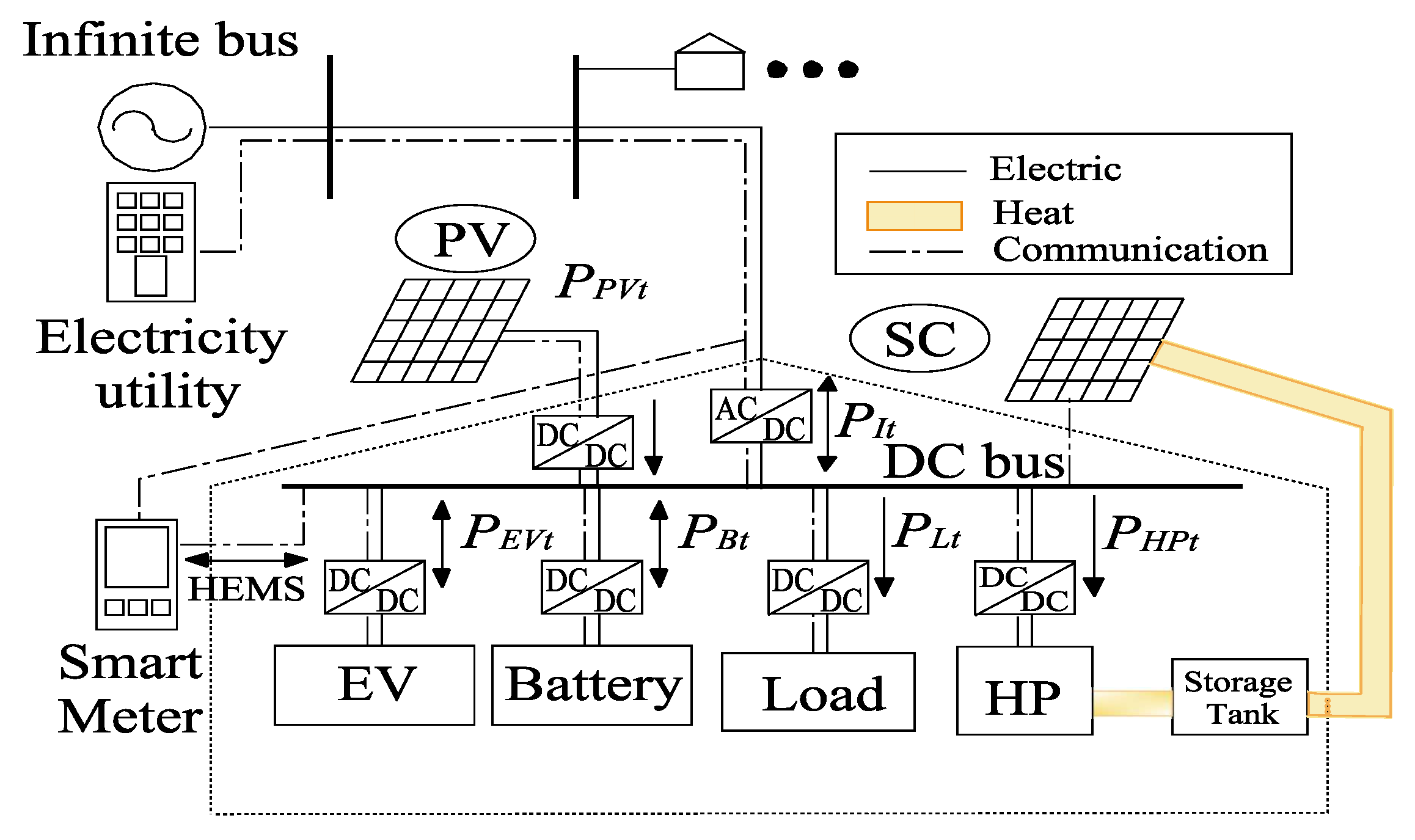

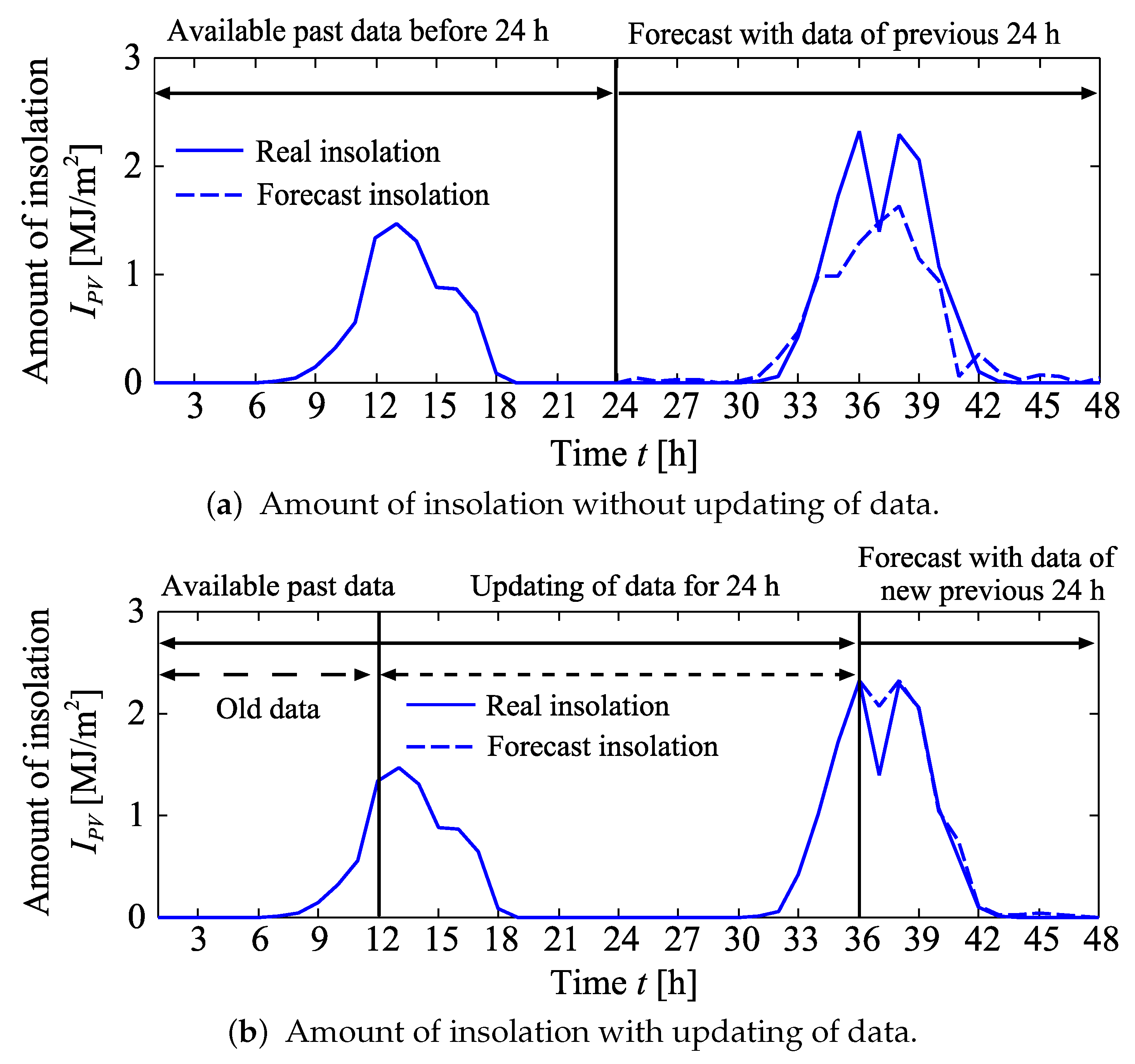
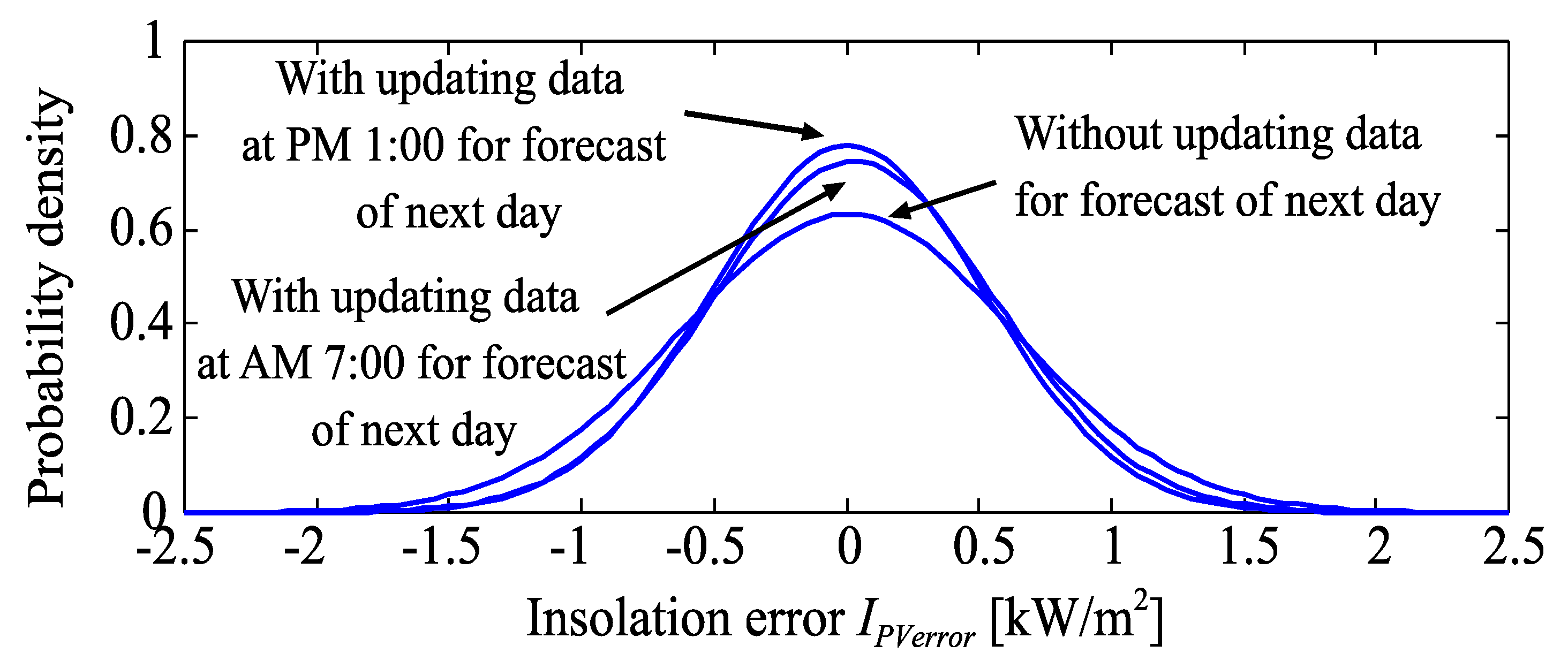
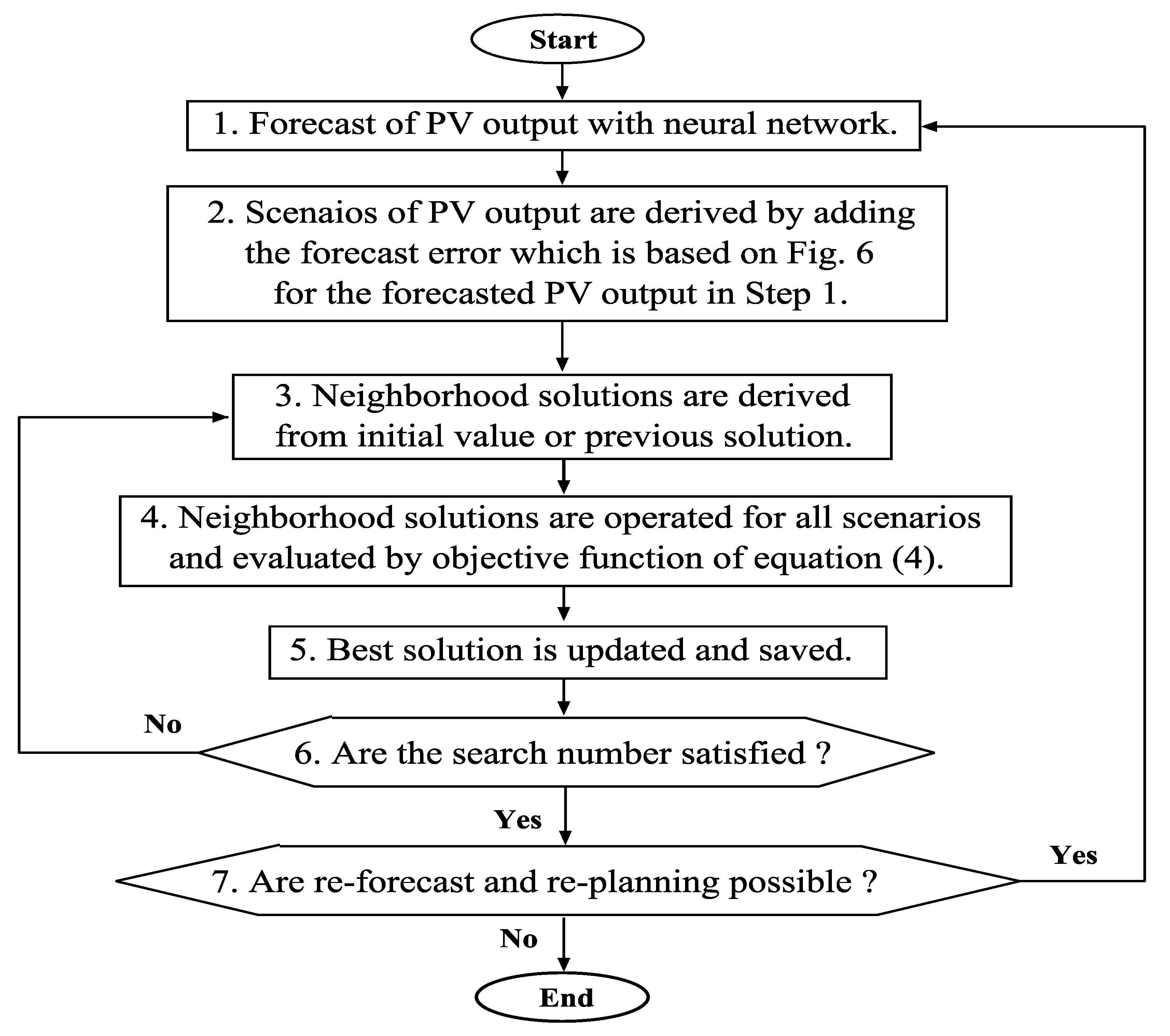
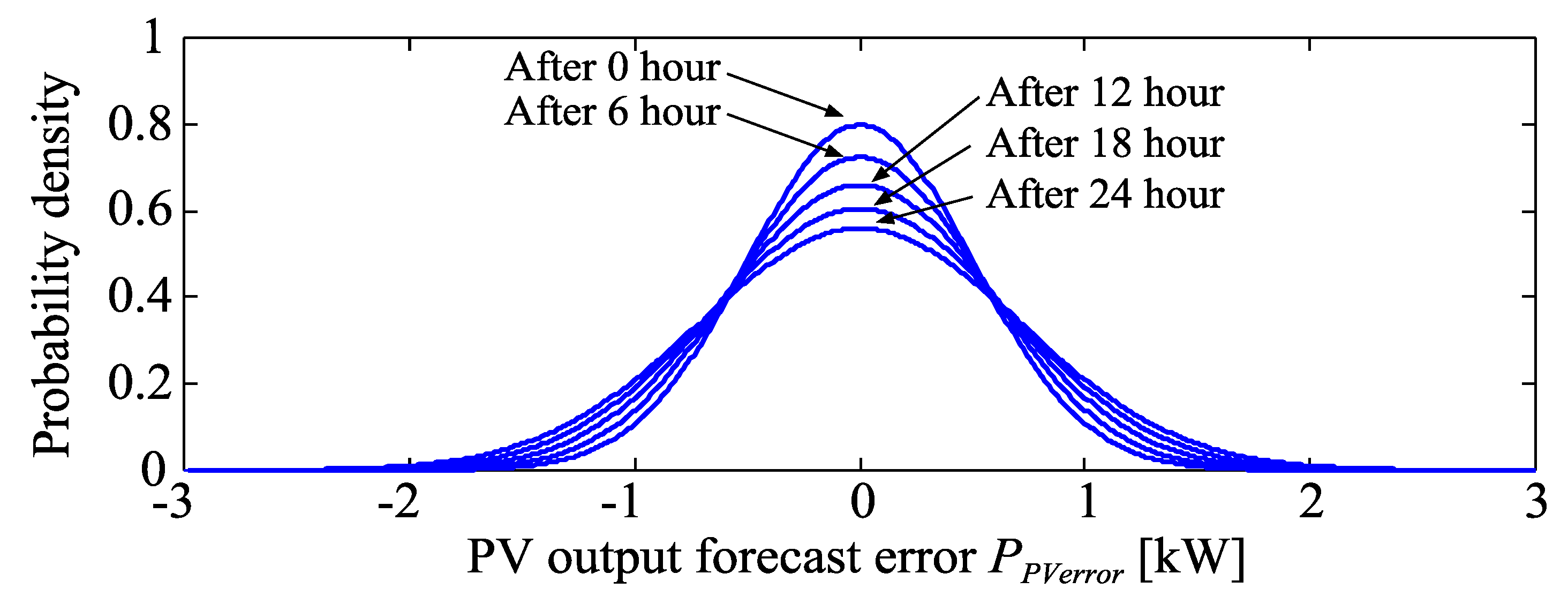
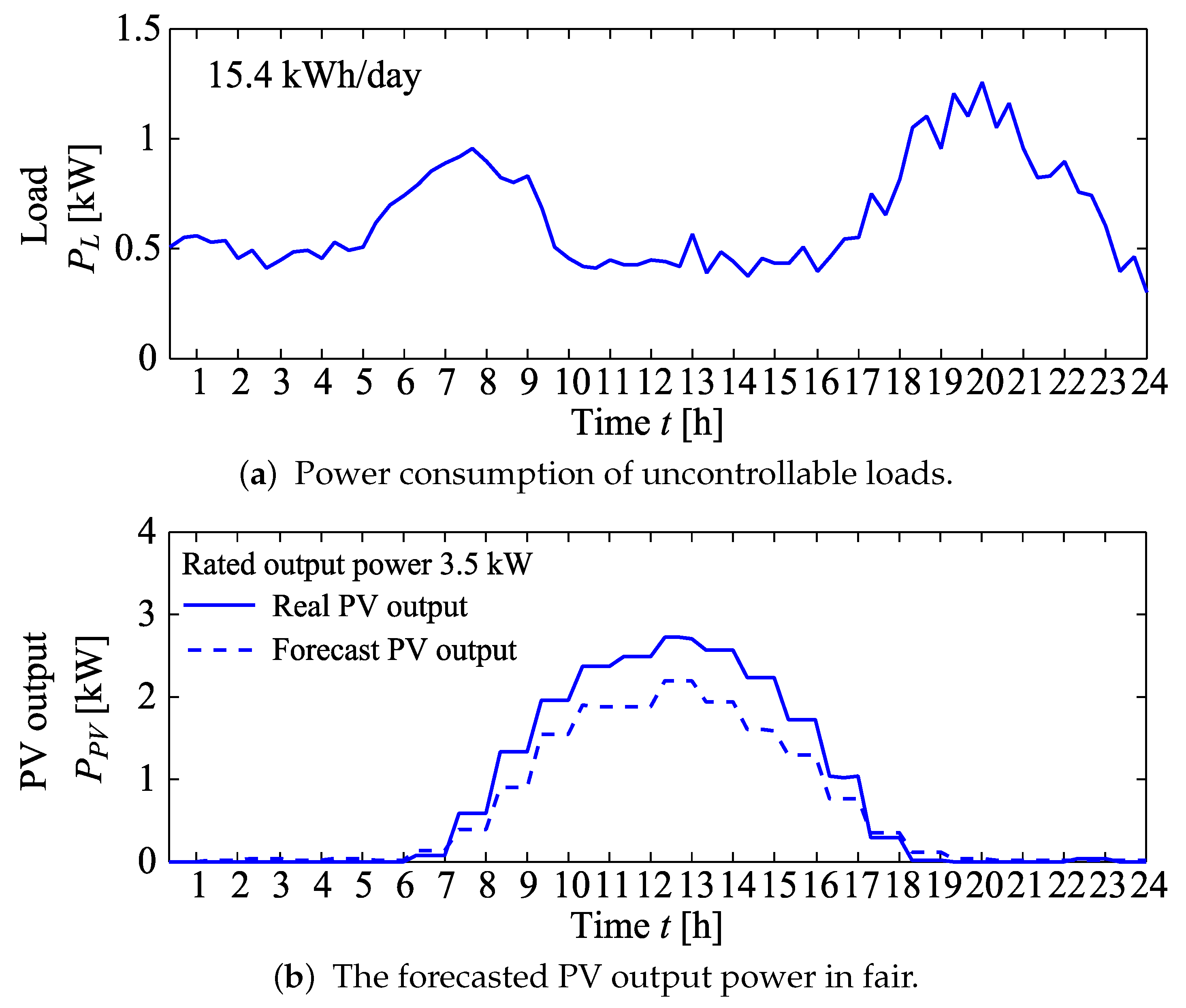
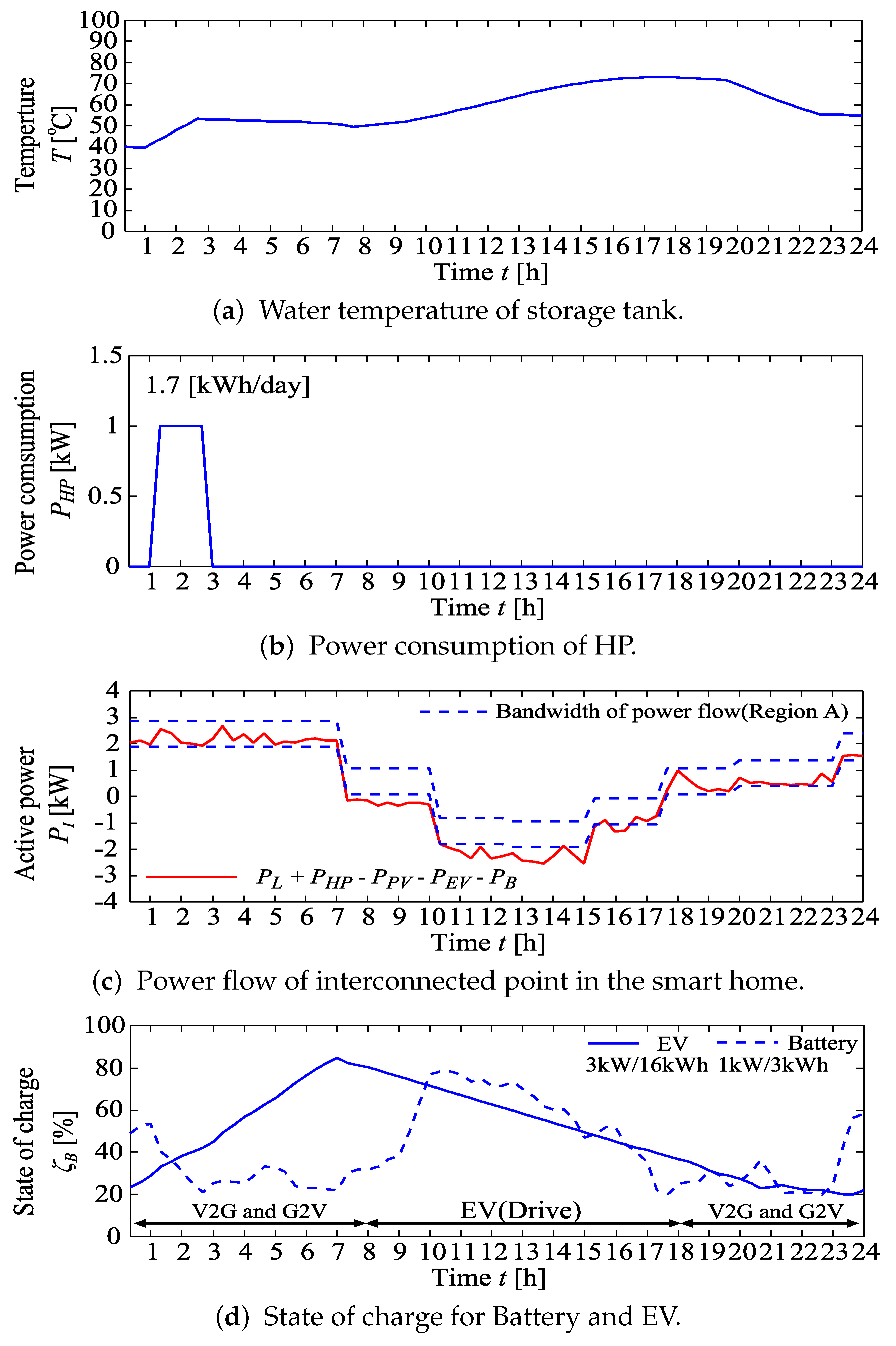
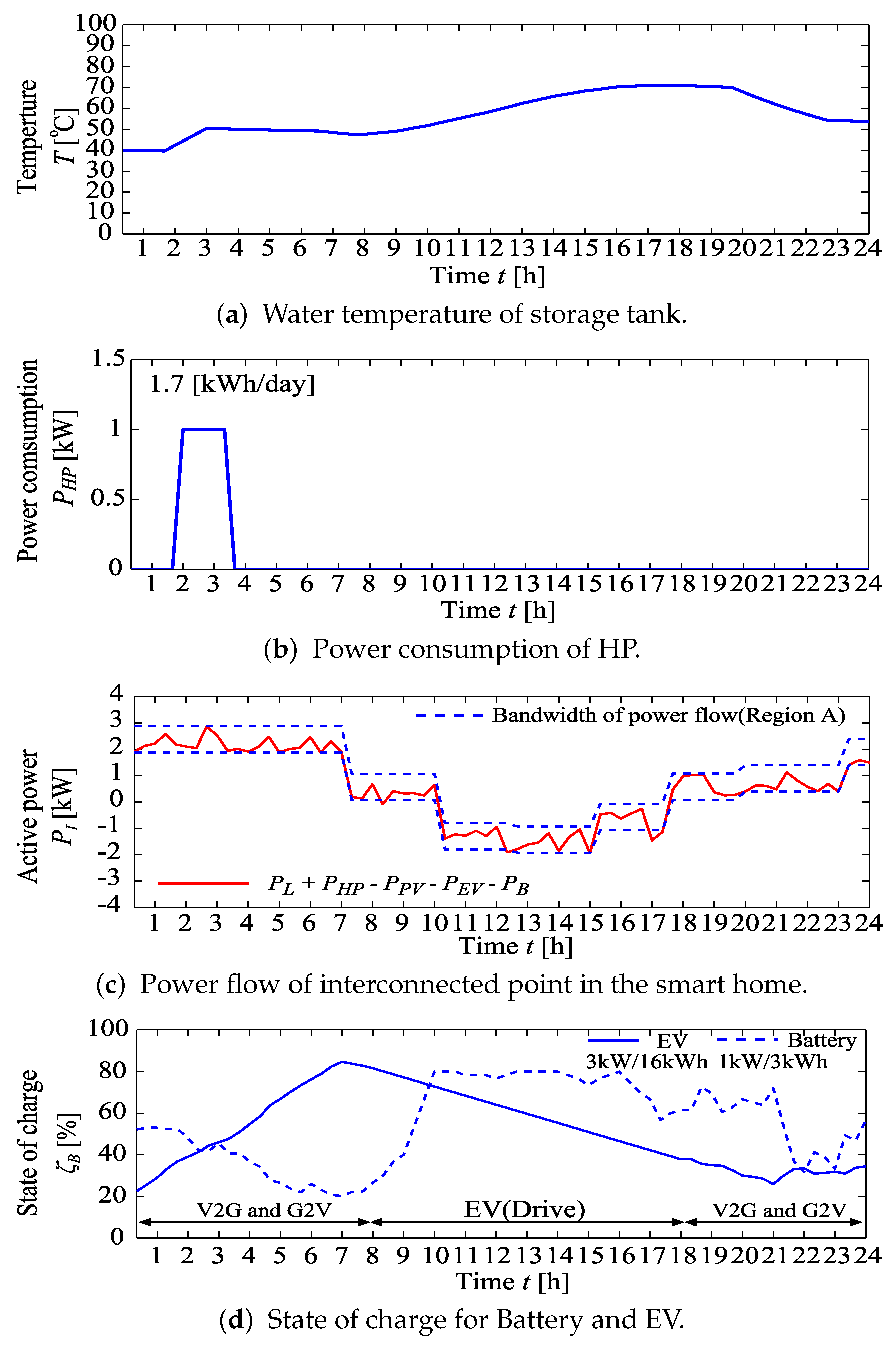
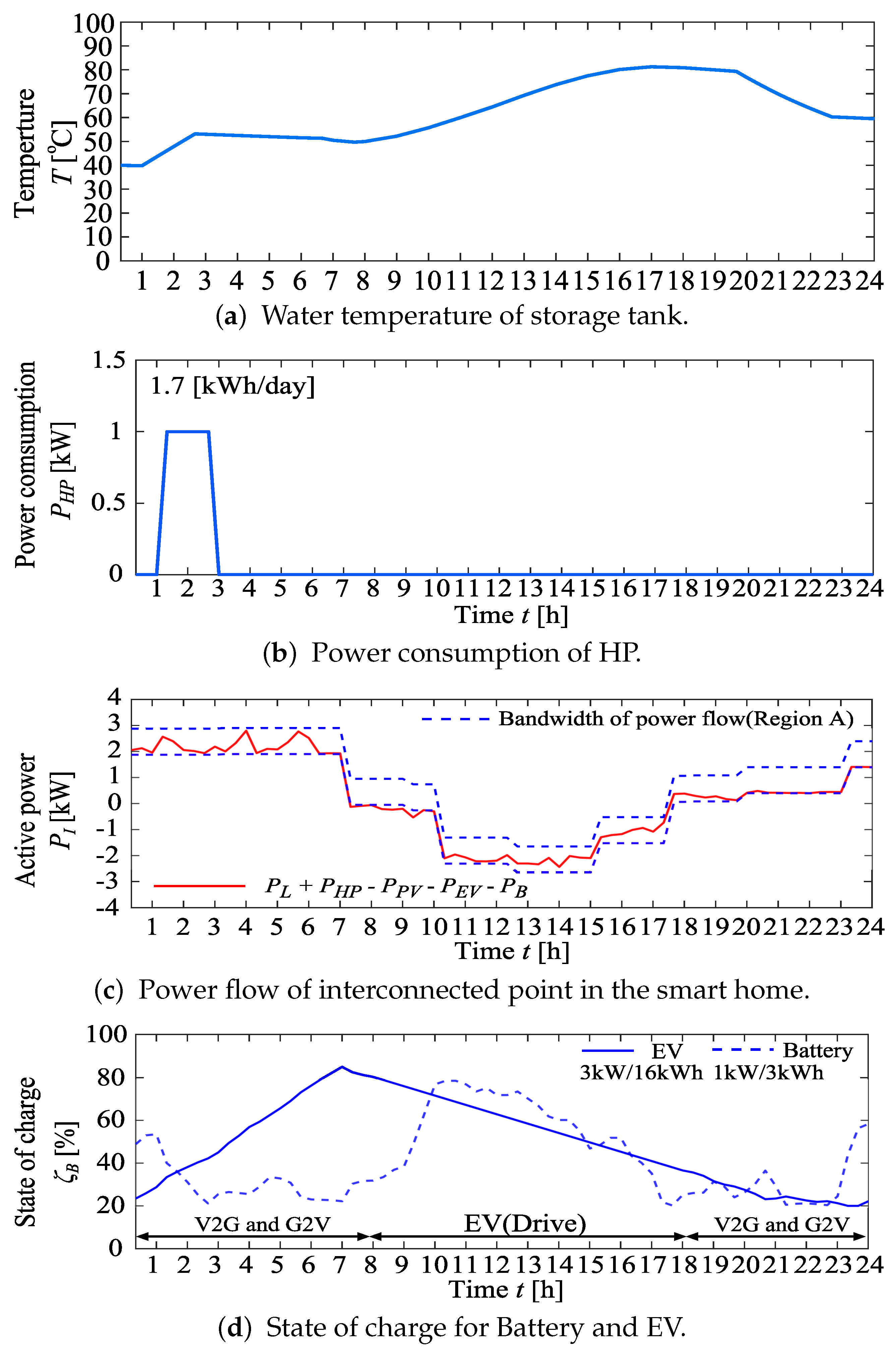
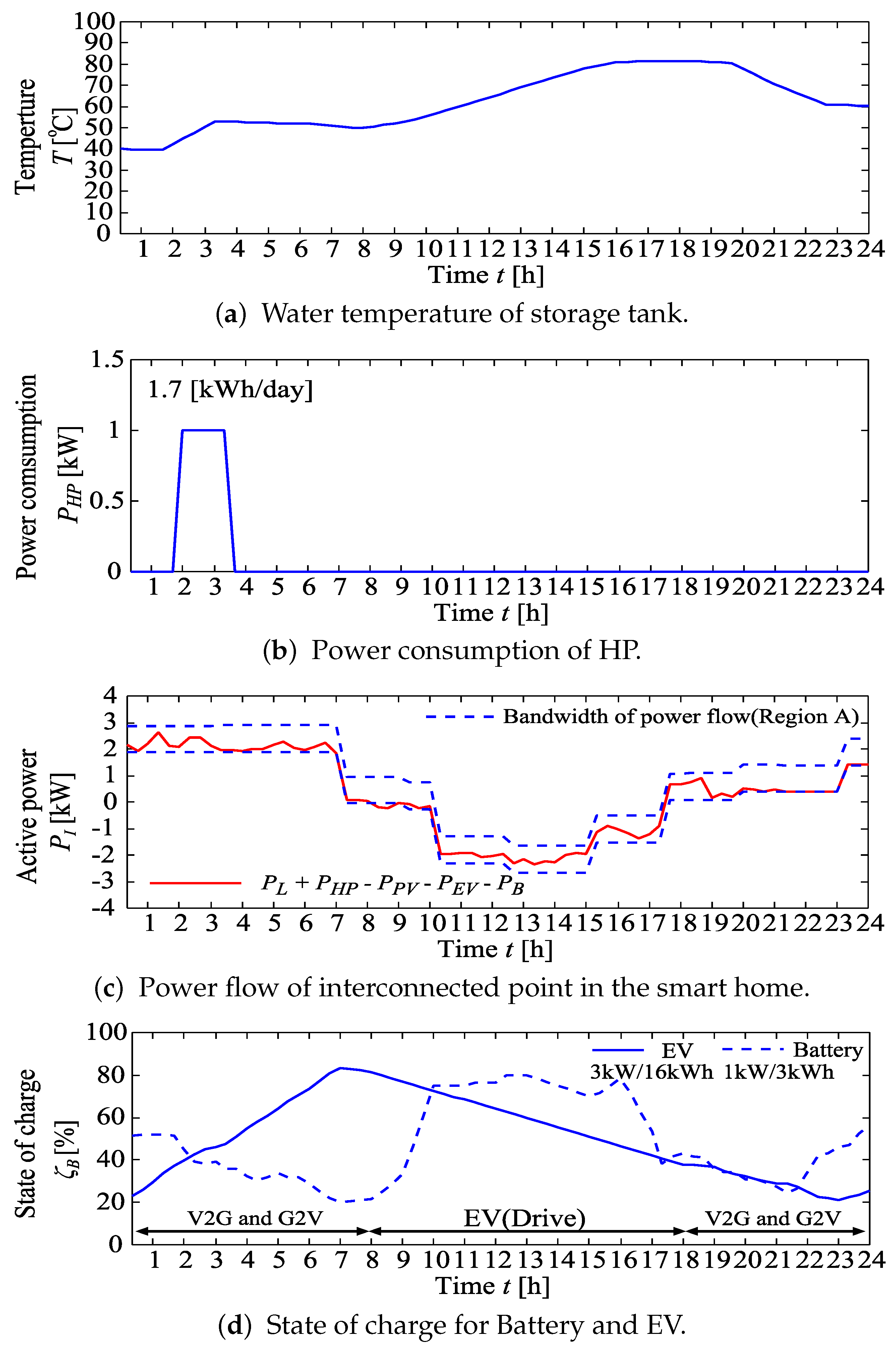
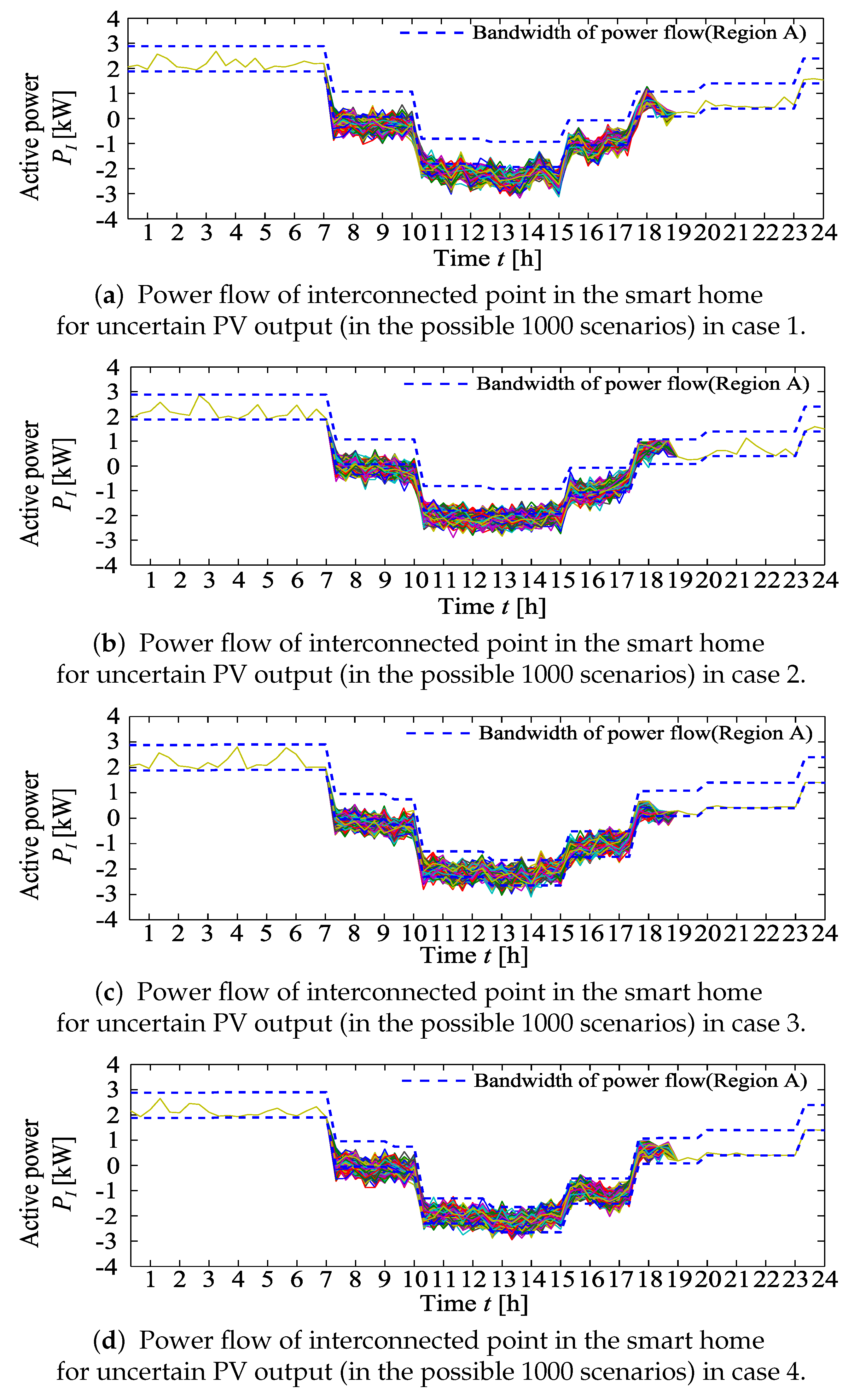
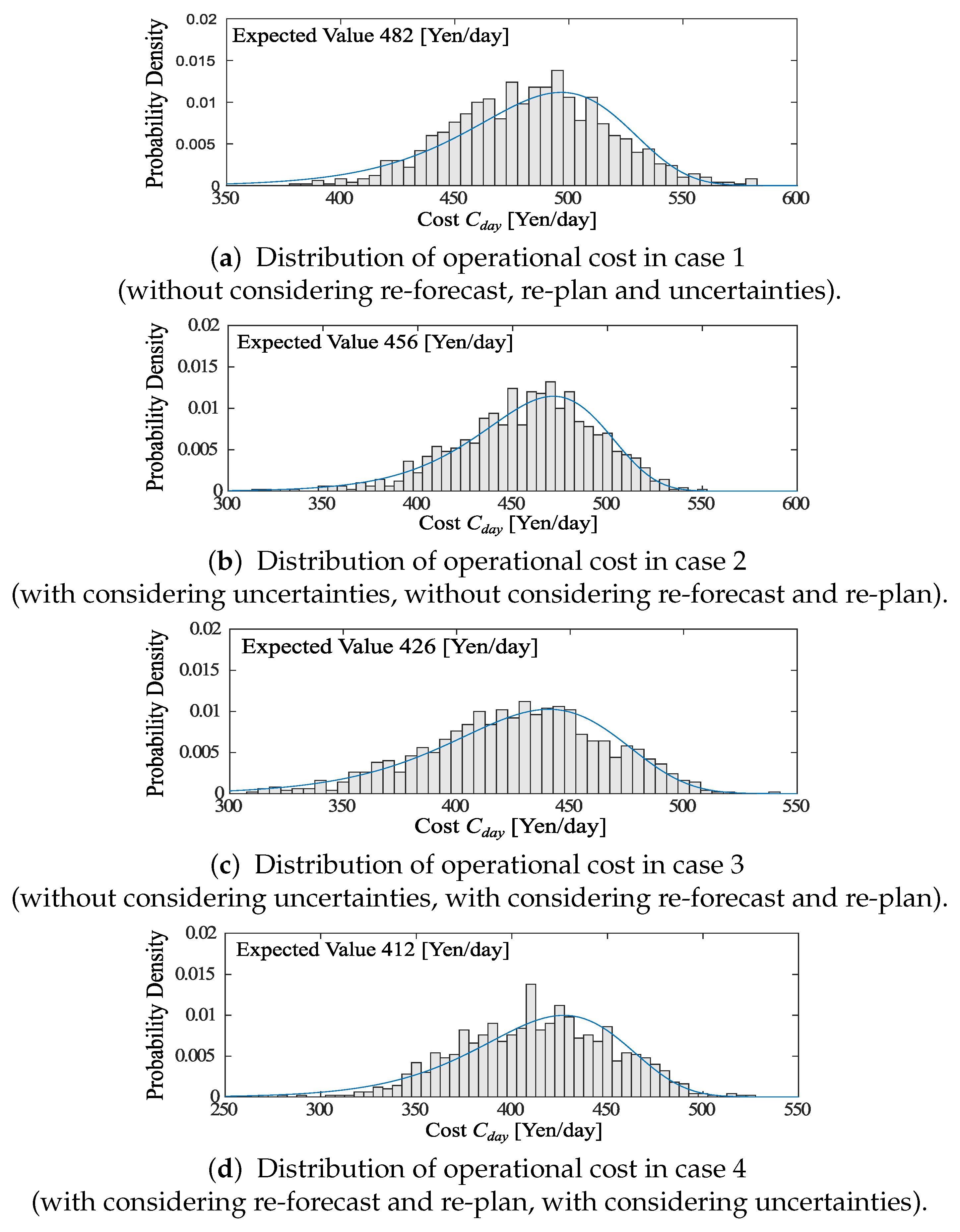
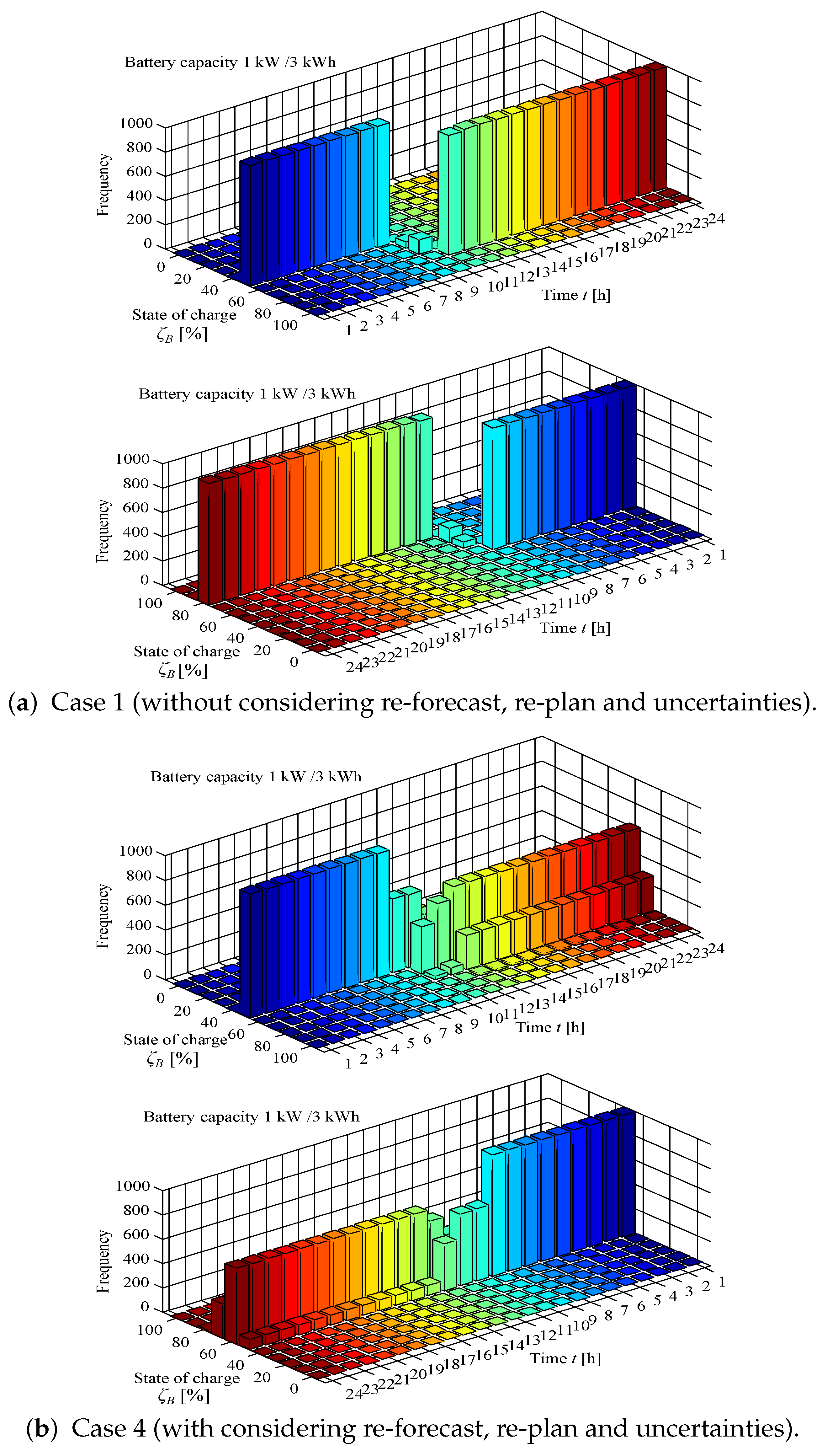
| Solar Heater Collector | ||
| Heat collection efficiency | 60% | |
| Heat collection area of one panel | 1.655 m | |
| Number of panels | 3 panels | |
| Heat Pump | ||
| Rated power consumption | 1 kW | |
| COP | 4.0 | |
| Capacity of water storage tank | 370 L | |
| : Electricity charge on energy usage amount | ||
|---|---|---|
| Electricity charge | In proportion to energy usage amount | |
| Unit price | Yen/kWh | |
| : Electricity charge on deviation from power command | ||
| Electricity charge | In proportion to deviation power | |
| Yen/kW | Region A | |
| Unit price | Yen/kW | Region B |
| Yen/kW | Region C | |
| Number of learning | 30,000 |
| Termination condition of error | 1.0×10 |
| Learning rate | 0.1 |
| Algorithm of updating weight | Steepest descent method |
| Input/output function | Sigmoid function |
| Input factor | Atmosphere, Temperature, Humidity, Hours of sunlight |
| Case 1 | Case 2 | Case 3 | Case 4 | |
|---|---|---|---|---|
| Consideration of uncertainties | × | ◯ | × | ◯ |
| Consideration of re-forecast and re-plan | × | × | ◯ | ◯ |
| Expected operational cost | 482 Yen/day | 456 Yen/day | 426 Yen/day | 412 Yen/day |
© 2019 by the authors. Licensee MDPI, Basel, Switzerland. This article is an open access article distributed under the terms and conditions of the Creative Commons Attribution (CC BY) license (http://creativecommons.org/licenses/by/4.0/).
Share and Cite
Yoza, A.; Uchida, K.; Chakraborty, S.; Krishna, N.; Kinjo, M.; Senjyu, T.; Yan, Z. Optimal Scheduling Method of Controllable Loads in Smart Home Considering Re-Forecast and Re-Plan for Uncertainties. Appl. Sci. 2019, 9, 4064. https://doi.org/10.3390/app9194064
Yoza A, Uchida K, Chakraborty S, Krishna N, Kinjo M, Senjyu T, Yan Z. Optimal Scheduling Method of Controllable Loads in Smart Home Considering Re-Forecast and Re-Plan for Uncertainties. Applied Sciences. 2019; 9(19):4064. https://doi.org/10.3390/app9194064
Chicago/Turabian StyleYoza, Akihiro, Kosuke Uchida, Shantanu Chakraborty, Narayanan Krishna, Mitsunaga Kinjo, Tomonobu Senjyu, and Zengfeng Yan. 2019. "Optimal Scheduling Method of Controllable Loads in Smart Home Considering Re-Forecast and Re-Plan for Uncertainties" Applied Sciences 9, no. 19: 4064. https://doi.org/10.3390/app9194064
APA StyleYoza, A., Uchida, K., Chakraborty, S., Krishna, N., Kinjo, M., Senjyu, T., & Yan, Z. (2019). Optimal Scheduling Method of Controllable Loads in Smart Home Considering Re-Forecast and Re-Plan for Uncertainties. Applied Sciences, 9(19), 4064. https://doi.org/10.3390/app9194064






